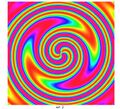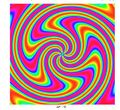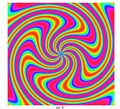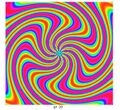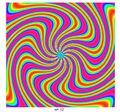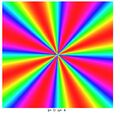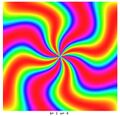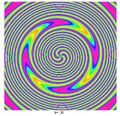Swirl function
From HandWiki
In mathematics, swirl functions are special functions defined as follows[1]:
- [math]\displaystyle{ S(k,n,r,\theta)=\sin(k\cos(r) -n\theta) }[/math]
where k and n are integers, and r and θ are polar coordinates.
When these functions are graphed, they usually resemble a swirling fan blade, where n is the number of blades, k is related to the shape of each blade.
Symmetry
The function S(k,n,r,θ) satisfies the following relations:
- mirror symmetry
- [math]\displaystyle{ f(-k, n, r, \theta)=-f(k, n, r, -\theta) }[/math]
- [math]\displaystyle{ f(-k, n, r, \theta)=-f(k, -n, r, \theta) }[/math]
- [math]\displaystyle{ f(-k, -n, r, \theta)=-f(k, n, r, \theta) }[/math]
- [math]\displaystyle{ f(-k, n, r, -\theta)=-f(k, n, r, \theta) }[/math]
- [math]\displaystyle{ f(-k, n, r, \theta)=-f(k, n, -r, -\theta) }[/math]
- [math]\displaystyle{ f(-k, n, -r, -\theta)=-f(k, n, r, \theta) }[/math]
- [math]\displaystyle{ f(-k, -n, -r, \theta)=-f(k, n, r, \theta) }[/math]
- [math]\displaystyle{ f(-k, n, -r, -\theta)=-f(k, n, r, \theta) }[/math]
- full symmetry
- [math]\displaystyle{ f(k, -n, r, \theta)=f(k, n, r, -\theta) }[/math]
- [math]\displaystyle{ f(k, -n, r, -\theta)=f(k, n, r, \theta) }[/math]
- [math]\displaystyle{ f(k, n, -r, \theta)=f(k, n, r, \theta) }[/math]
- [math]\displaystyle{ f(k, n, -r, \theta)=f(k, n, r, \theta) }[/math]
- [math]\displaystyle{ f(k, n, -r, \theta)=f(k, -n, r, -\theta) }[/math]
- [math]\displaystyle{ f(k, -n, -r, -\theta)=f(k, n, r, \theta) }[/math]
- [math]\displaystyle{ f(k, n, -r, \theta)-f(k, n, r, \theta) }[/math]
- rotation symmetry
- [math]\displaystyle{ S\left(k,n,r,\theta+\frac{2\pi}{n}\right)=S(k,n,r,\theta) }[/math]
examples
First number is n, second is k
References
- ↑ Trott, M. Graphica 1: The World of Mathematica Graphics. The Imaginary Made Real: The Images of Michael Trott. Champaign, IL: Wolfram Media, pp. 36–37 and 86, 1999.

